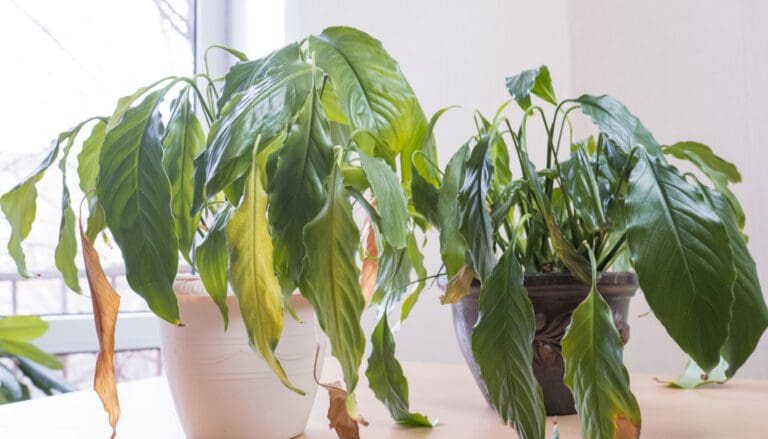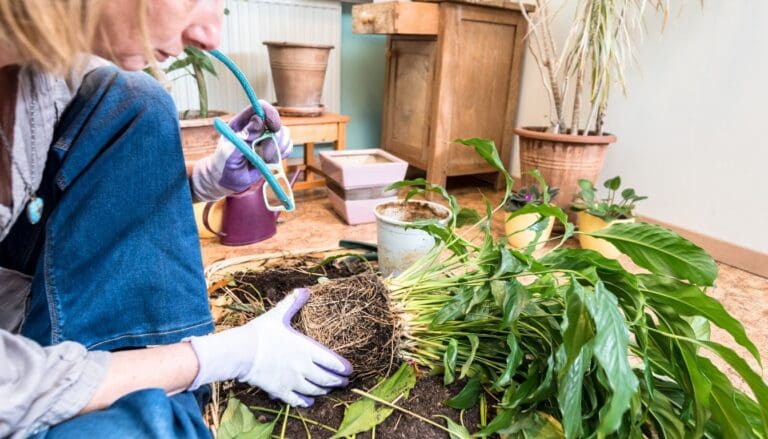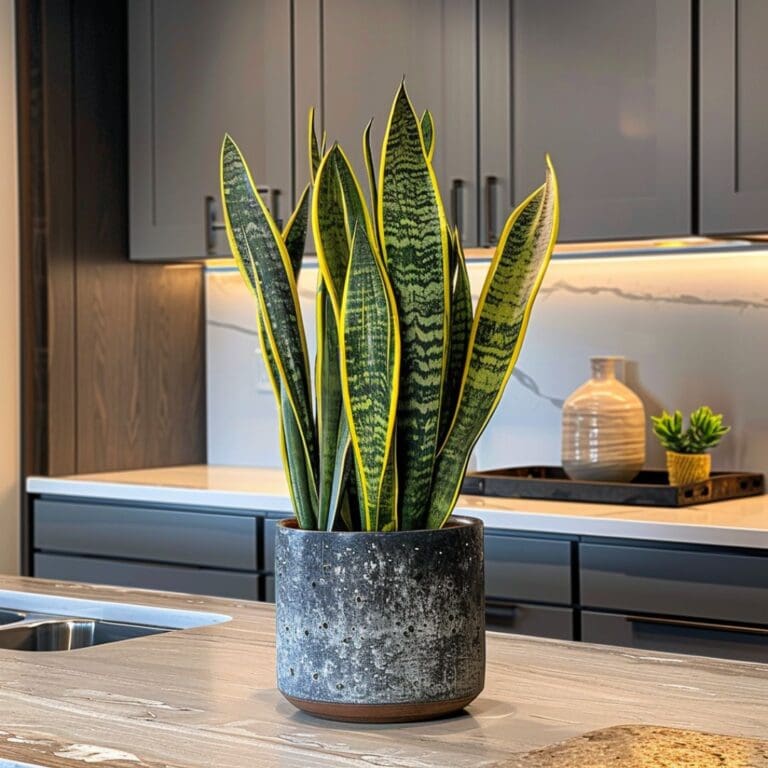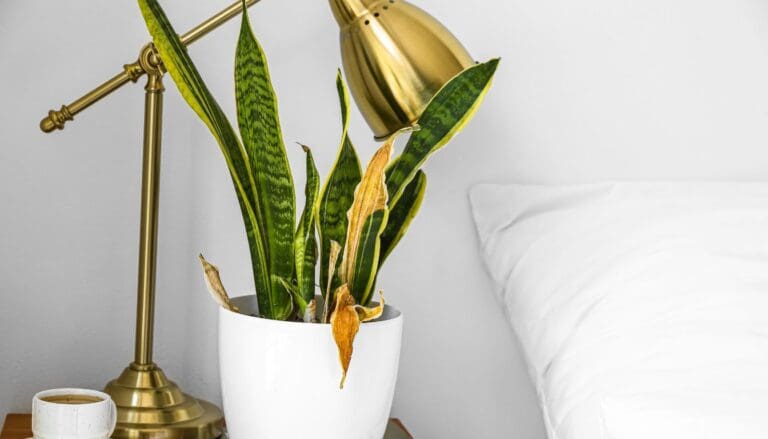English Ivy Pests And Diseases: Signs, Causes+How To Eliminate
In the last few years, English ivy plants have become popular as ornamental vining plants due to their hardiness and low maintenance nature. Don’t be baffled by the pests and fungus on your English ivy if you’ve not provided the ideal growing conditions.
Pests like gnats, spider mites, and mealybugs can infest your English ivy. They are also prone to bacterial and fungal diseases such as root rot. Whenever you see signs of pests or diseases, treat your ivy with Neem oil, pesticides, and fungicides and provide appropriate conditions for new growth.
In this article, I will discuss all the pests and diseases that can destroy your English ivy and give solutions to cure and prevent the problem.

Please note: Simplify Plants is reader-supported. Some links in the post are affiliate links and I get a commission from purchases made through links in the post.
What is eating my ivy?
English ivies are strong and sturdy plants that can tolerate various conditions.
But, no matter how resistant they are, if pests and disease-causing fungus attack any plant, it is difficult for the plant to overcome that recovery.
When you grow plants, you should act as soon as possible whenever you notice the first signs of any diseases or pests.
Pests that attack your ivy stick to the plant and gradually suck its nutrients.
If left untreated, these pests multiply quickly and suck out the plant’s nutrients and energy, gradually weakening and killing it.
Several conditions attract these bugs, like excessive dampness, high humidity, overwatering, etc.
Now let us look into the different types of bugs that attack English ivies:
Spider mites

Spider mites mostly attack plants that are dehydrated and have low moisture and humidity around them.
They are extremely tiny and are almost invisible.
You will find these mites on the undersides of the leaves.
They suck the sap containing the nutrients from the veins of the leaves.
These spider mites weave webs around the plant, ultimately rendering them weak.
One of the earliest signs of spider mites infestation is the white dots on the leaves.
Scales

Scales are of various types, but the most common are brown and are very difficult to treat as most pesticides cannot pierce through their shield and kill them.
They remain immobile while feeding and are often mistaken as tiny bumps on the plants and feed on the plant’s sap.
They stop the plant from growing, and it gets yellow and wilted.
Mealybugs

These are one of the nastiest bugs that are also hard to remove from plants.
They are tiny white waxy-looking bugs that stick to the leaves and stems of the plant, sucking the nutrients with their tube-like mouths.
As they consume the nutrients, they secrete honeydew which further invites the ants to attack the plant.
The plant begins to wilt and turn yellow, stops growing, and dies.
Fungus gnats

They are brown-colored flies found hovering in groups around overwatered damp plants.
The larvae of these gnats can pierce the roots of the ivy and feed on them.
Snails and slugs
These nasty bugs hide during the days as they cannot tolerate the hot sun and comes out at night to feed on the ivy.
They thrive in damp and dark areas and avoid bright light.
Like the other pests, they feed on the sap and reproduce at night when the temperatures go low.
It is difficult to notice them, and you must identify them when you notice the damage in the early morning.
Snail or slug baits are used to catch these nasty bugs.
Aphids

They are oval-shaped, come in multiple colors like yellow, white, and brown, and are fond of a damp and moist environment.
Overwatered soil and low light conditions are primary causes of aphids invading the plants.
They feed on the tender tissues of the plant, causing the leaves to curl up and multiply rapidly.
They excrete honeydew which attracts black mold fungus to the plant.
Caterpillars

Caterpillars are mostly seen in ivies that are grown outdoors.
They hatch the larvae on the leaves of the plant that begins to eat on them, making the leaves have ragged holes and edges on them.
How to get rid of pests on English ivy?
Now we will discuss the steps you need to remove pests from your English ivy.
1. Isolate the plant
Whenever you notice any pests, you must separate the ivy from the other plants in the house.
These bugs are highly contagious and quickly spread from one plant to another.
So without any delay, isolate the plant.
2. Prune the infected parts

If you notice the pests crowded at one particular spot in the plant, prune that part.
Sterilize the pruning shears before and after use to prevent the spread of these pests.
Do not prune more than 25% of the ivy at once, as that would put the plant under immense pressure.
3. Start the treatment
Now that you have done the preparatory steps, you must start the treatment.
For this, there are two available options.
First, use organic pesticides like Neem oil, and second is more effective stronger chemical pesticides.
Using organic pesticides is best for houseplants.
But if you still find pests after using them, you can move to chemical pesticides.
4. Wash the ivy under running water
Wash your ivy plant under strong running water targeting the spots where the pests are attached.
Do this on this day so the plant gets enough light to dry out.
5. Use rubbing alcohol
Make a solution of:
- 3 parts water
- 1 part rubbing alcohol
Spray it all over the infested areas, dip a cotton ball in the solution, and dab it over to clear all the sticky pests.
6. Use insecticidal soaps
Insecticidal soap is another organic way that helps to get rid of all the pests.
Mix:
- 4 cups of water
- 1 tablespoon of liquid soap
Spray this all over your plant 2-3 times every week until you see the bugs clearing.
But you must do this only during the late afternoon so that the sunlight does not damage it.
This soapy mixture will kill the pests by impairing the cell membranes.
You can also get a ready-made one in the market.
7. Neem oil solution

Neem oil is the most effective ad popular organic pesticide to cure and prevent pest infestations on plants.
This damages the bugs’ hormones, preventing them from functioning normally and killing them.
However, it is not effective on hard shield insects like scales but clears most pests, including mealybugs, spider mites, etc. make this mix and spray it all over the plant:
- 1-liter water
- 1 tablespoon liquid soap
- 1 tablespoon Neem oil
8. Horticulture oil
This is an effective way to kill the pests, but do not use this if you live in regions with extremely high or low temperatures.
9. Rotenone
Spray this highly toxic pesticide once weekly, maintaining a safe distance from the plant as it harms humans and pets.
10. Sticky traps
They are effective in trapping flying bugs like gnats and aphids.
The pests get drawn to them, and the jelly on the tapes traps them.
11. Ryania
This is a poisonous powder procured from a dried stem.
Dust them on the bugs to kill them.
However, be careful if you have pets at home.
12. Pyrethrum powder
These can be diluted in water and sprayed or just dusted on the ivy.
It paralyzes the bugs and kills all of them.
13. Diatomaceous earth
This organic insecticide paralyzes all the bugs and removes them from the English ivy.
It restricts the movement of the pests, causing dehydration and killing them.
14. Linalool/limonene
If none of the above ways work, use these strong chemical pesticides to kill the bugs.
English ivy diseases

English ivy is very hardy but is also attacked by several diseases causing fungus, which causes extensive damage when left unchecked.
Let us know about a few diseases that are commonly known to occur in this plant.
1. Anthracnose
These are very often mistaken as bacterial leaf spots.
They can be identified by circular areas that develop into brown dry, or black spots that usually begin near the margins of the leaves.
They spread easily from one plant to another by splashing water droplets, windblown rain, or insects.
How to fix it?
- Water early in the morning so that the foliage gets dry before evening.
- Do not physically disturb the plants when they are wet.
- Apply fungicides that are labeled for the control of anthracnose.
- Control insects and mites infestations.
2. Bacterial leaf spot
Bacterial leaf spots appear on the upper and lower surfaces of the leaves as brown, green, or black water-soaked(oily) spots.
They occur initially on the older leaves and spread to newer leaves.
They spread easily through water and densely crowded plants.
Bacterial leaf spot infection most often occurs in plants where the leaves stay wet and are kept under the shade without bright light.
Damp, poorly ventilated areas have higher chances of disease development.
How to fix it?
- Do not keep the leaves wet.
- Keep plants in well-ventilated areas.
- Make sure the ivy plant gets some sunlight.
- Remove all the infected plant parts.
- Sanitize the tools and equipment before and after use.
- Avoid overhead watering as splashing water spreads the fungus quickly.
3. Edema
Edema is a condition caused by excessive moisture and wetness in the foliage.
Initial signs include water-soaked tiny spots on the undersides of the leaves.
It is most commonly seen during wet, cloudy seasons, winters, or springs.
The primary causes of edema are wet soil, poor ventilation, too much moisture in the air, and low light conditions.
How to fix it?
To prevent edema, you need to cut down on watering, as overwatering is the most common cause of edema.
4. Phytophthora root rot and leaf spot
This disease occurs in most English ivy plants that grow in poor soil with insufficient drainage.
Warm temperature coupled with overwatering and high moisture contribute to the development of this disease.
The infection begins at the roots, the plant begins to wilt, and the black lesions gradually rise upwards and cover the entire plant.
How to fix it?
- Discard the diseased plants.
- Sanitize the tools before and after use.
- Sterilize the pots with disinfectant.
- Do not reuse a diseased plant’s potting mix to grow other plants.
- Ensure the soil used for your ivy is well draining and does not hold excess water.
- Mix soil with perlite, sand, or pine bark as they improve the soil structure by allowing drainage.
- Apply fungicide and prune off the decayed parts
5. Rhizoctonia root rot and aerial blight
Rhizoctonia aerial blight is another fungal disease that invades English ivies in hot and humid conditions.
The fungus pathogens thrive inside the soil, multiply quickly, and travel through the air.
Initially, the disease causes brown spots and wet spots, and gradually they form a spider web-like structure that covers the entire plant, gradually killing it.
How to fix it?
- Spray fungicide on the foliage generously
- Drench the soil with the same fungicide
- Trim the infected leaves and parts
- If the soil is severely infested, discard it and grow the ivy in fresh soil.
6. Botrytis blight
This common disease attacks the English ivies growing in landscape and greenhouses and is mostly seen in cool conditions around late fall, winter, and early spring.
In this, a gray mold covers the leaves and the stems in cool and humid conditions.
This gradually increases and becomes covered with grey-brown fuzz made up of fungus.
How to fix it?
- Lower the humidity around the plant.
- Cut down on fertilization.
- Reduce watering.
English ivy diseases prevention

You can prevent the invasions of disease-causing fungus by giving the plant an ideal growing condition.
Let us discuss them below.
- Keep your English ivy at a spot that receives bright indirect light. These plants enjoy 3-4 hours of morning sunlight in colder climates.
- Do not keep your plant in a low-light area as that will attract pests and diseases t the plant. Low lights reduce the evaporation, which keeps the soil wet for a longer time giving rise to chances of root rot.
- Always mist the plat only in the morning, so the leaves get dry by evening.
- If your home has poor natural light, install artificial lights to give the plant the required light and heat.
- Use well-draining soil to grow your ivy. Do not use chunky clayey soil as they tend to hold a lot of moisture.
- Water your English ivy only when the top 2 inches of the soil are dry. If you are unsure of when to water, use a moisture meter.
- Use pots with drainage holes to grow your plant.
- Do not forget to empty the cache below the pots where the excess water accumulates.
- Do not keep your ivy plant dehydrated for a prolonged period. Dehydration makes the plant weak, which becomes an easy target for pests and fungi to invade the plant.
- English ivy needs 40% humidity around them, so a humidifier is a great way to keep the environment humid. You can also increase or decrease the levels of humidity on a humidifier. If you are unsure about the humidity level, get a hygrometer to measure it.
- Make sure you keep the plant at a spot with sufficient air circulation. Do not keep the plants too crowded in a corner as that restricts the airflow between them.
- Keep the leaves of your ivy free of dust. Misting them helps keep them clean. Cleaner leaves help the plant to photosynthesize efficiently.
- Spray your ivy with a Neem oil solution every month to repel pests and fungus.
- Observe the plant and keep an eye on its health. If you notice any sign of fungus or pest, act immediately without delay.
Final words
This article has extensively discussed the bugs and fungi that disturb the English ivy plants. If any such bugs or diseases have attacked your ivy, this article will help you.
And even if your ivy is healthy, following the above precautions will keep your plant free of pests and prevent any infestations in the future. The primary goal is to keep your ivy in an ideal condition because pests and diseases strike the plants growing in unfavorable conditions.
Reference: Researchgate, University of Tennessee, Mississippi State University, Central Florida Research and Education Center, U.S. DEPARTMENT OF AGRICULTURE.
Recommended Garden Supplies
| Product Image | Our Recommended Gardening Supplies | Check Offers! |
|---|---|---|
Top Top
Top
Top
Top
Top
Top
Top
Top | rePotme Houseplant and Tropical Classic Potting Soil Mix | Check Offer On Amazon |
 Top
Top
Top
Top
Top
Top
Top
Top | Espoma Organic Indoor Plant Food | Check Offer On Amazon |
 Top
Top
Top
Top
Top
Top
Top
Top | GooingTop LED Grow Light 6000K Full Spectrum Clip Plant Growing Lamp | Check Offer On Amazon |
 Top
Top
Top
Top
Top
Top
Top
Top | Soil Moisture Meter | Check Offer On Amazon |
 Top
Top
Top
Top
Top
Top
Top
Top | Govee Hygrometer Thermometer, Bluetooth Enabled! | Check Offer On Amazon |
 Top
Top | LEVOIT Humidifiers for Large Room(Best For Plants) | Check Offer On Amazon |
 Top
Top
Top
Top
Top
Top
Top
Top | Upgraded DIY Automatic Drip Irrigation Kit, 15 Potted Houseplants Support | Check Offer On Amazon |
 Top
Top
Top
Top
Top
Top
Top
Top | Stainless Steel Heavy Duty Gardening Tool Set | Check Offer On Amazon |
 Top
Top
Top
Top
Top
Top
Top
Top | Bonide Insecticidal Soap | Check Offer On Amazon |
 Top
Top
Top
Top
Top
Top
Top
Top | Bonide 32 oz Spray Neem Oil for Organic Gardening | Check Offer On Amazon |
 Top
Top
Top
Top
Top
Top
Top
Top | Garden Safe Fungicide | Check Offer On Amazon |







I have a very old, inherited ivy houseplant. Something is eating the leaves, and the leaves have brownish spots. There is some residue, looks like course ground pepper on the table around the pot. I can’t see anything on the leaves at all, it’s driving me crazy.
It sounds like your ivy plant may be experiencing a pest infestation. The brownish spots on the leaves could be a sign of fungal or bacterial infection, which can be caused by overwatering or poor air circulation. The residue you mentioned could be insect droppings, which could indicate the presence of spider mites or aphids.
To address this issue, you can start by inspecting the plant closely for any visible signs of pests. You can also try wiping the leaves with a damp cloth to remove any residue or insects. Additionally, make sure the plant is getting adequate sunlight and airflow, and be careful not to overwater it.
If the problem persists, you may need to use an insecticide or fungicide to treat the plant. Be sure to follow the instructions carefully and use a product that is safe for indoor use. With some care and attention, your ivy plant should be able to recover and thrive.
My ivy plants are the only plants that die. They look, after a few months: grey, dusty and lifeless.
My other plants are so healthy and wonderful that I wonder why it’s only the ivy that doesn’t like the same environment. So, I’m treating it as you instructed and putting it in strong sunlight that comes in by the front door in the morning.
And I’ll mist it daily in the morning.
Wish me luck!
Thanks.
Hey patricia,
I hope your ivy does well this time!